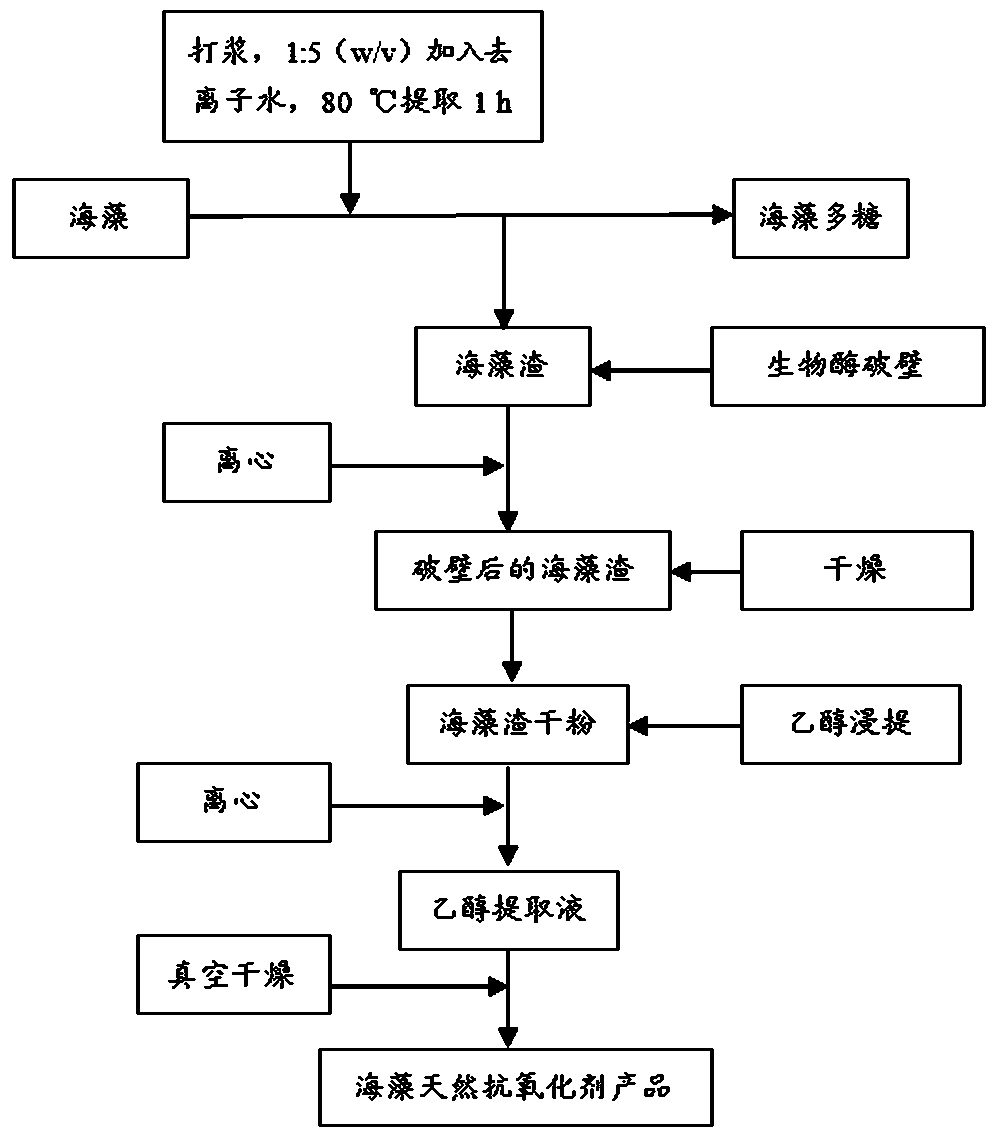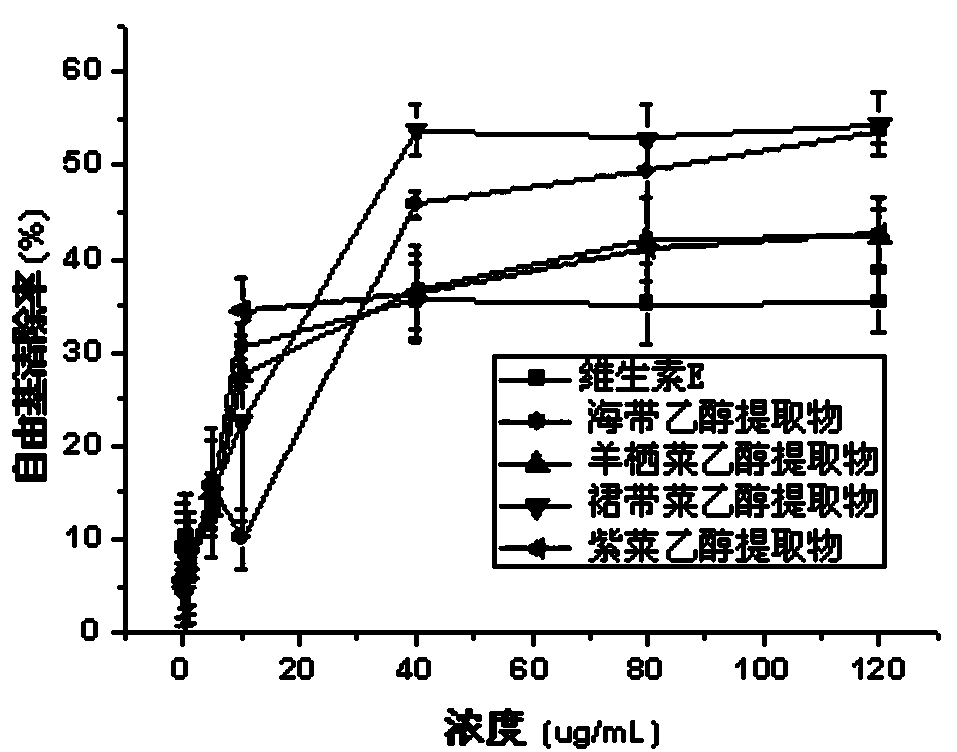Preparation method of alga natural antioxidant
A natural antioxidant, seaweed technology, applied in food preparation, medical preparations with inactive ingredients, pharmaceutical formulations, etc., can solve problems such as waste of resources, achieve strong antioxidant capacity, better wall breaking effect, and maximize The effect of using
- Summary
- Abstract
- Description
- Claims
- Application Information
AI Technical Summary
Problems solved by technology
Method used
Image
Examples
Embodiment 1
[0048] Example 1: Kelp Preparation Seaweed Natural Antioxidant
[0049] (1) Take 500 g of fresh kelp, cut it into pieces with scissors, beat with a beater, add 2.5 L of deionized water, and stir evenly;
[0050] Extract at 80 ℃ for 1 h, centrifuge with a tubular continuous centrifuge (3000 r / min, 5 min), take the sediment, and obtain 356.9 g of seaweed residue; the seaweed residue is dried, crushed, and passed through an 80-mesh sieve to make seaweed residue dry powder 75.8 g;
[0051] (2) Take 50 g of the above dry kelp residue powder and 0.25 g of compound enzyme and mix well, add 754 mL of deionized water, and stir evenly. After reacting for 5 h at room temperature at 20 °C, centrifuge in a tubular continuous centrifuge (3000 rpm for 5 min) to obtain kelp residue. In this step, the seaweed residue is treated with biological enzymes to break the wall, so that the polyphenols, fucoxanthin and other antioxidant substances in the seaweed can be fully dissolved, thereby sign...
Embodiment 2
[0057] Example 2: Hijiki preparation seaweed natural antioxidant
[0058] (1) Take 500 g of hijiki, cut it into pieces with scissors, beat it with a beater, add 2.5 L of deionized water, and stir well.
[0059] Extract at 80 ℃ for 1 h, centrifuge in a tubular continuous centrifuge (3000 r / min, 5 min), take the sediment, and obtain 385.7 g of seaweed residue; the seaweed residue is dried, crushed, and passed through an 80-mesh sieve to make seaweed residue dry powder 81.4g;
[0060] (2) Take 50 g of the above seaweed dregs dry powder and mix well with 0.25 g of compound enzyme, add 1005 mL of deionized water, and stir evenly. After reacting for 5 h at room temperature at 20 °C, centrifuge in a tubular continuous centrifuge (3000 rpm, 5 min) to obtain seaweed residue;
[0061] (3) The above-mentioned seaweed residue was dried in an oven at 80 °C for 6 h to obtain 46 g of dried seaweed residue after breaking the wall;
[0062] (4) Add 368 mL of food-grade absolute ethanol to...
Embodiment 3
[0065] Example 3: Wakame preparation seaweed natural antioxidant
[0066] (1) Take 500 g of fresh wakame, cut it into pieces with scissors, beat with a beater, add 2.5 L of deionized water, and stir evenly;
[0067] Extract at 80°C for 1 h, centrifuge with a tubular continuous centrifuge (3000 r / min, 5 min), take the sediment, and obtain 322.5 g of seaweed residue; the seaweed residue is dried, crushed, and passed through an 80-mesh sieve to make seaweed residue dry powder 65.2 g;
[0068] (2) Take 50 g of the above-mentioned seaweed residue dry powder and 0.25 g of compound enzyme and mix well, add 1256 mL of deionized water, and stir evenly. After reacting for 5 h at room temperature at 20 °C, centrifuge in a tubular continuous centrifuge (3000 rpm, 5 min) to obtain seaweed residue;
[0069] (3) The above-mentioned seaweed residue was dried in an oven at 80 °C for 6 h to obtain 43 g of dried seaweed residue after breaking the wall;
[0070] (4) Add 430 mL of food-grade ...
PUM
 Login to View More
Login to View More Abstract
Description
Claims
Application Information
 Login to View More
Login to View More - R&D
- Intellectual Property
- Life Sciences
- Materials
- Tech Scout
- Unparalleled Data Quality
- Higher Quality Content
- 60% Fewer Hallucinations
Browse by: Latest US Patents, China's latest patents, Technical Efficacy Thesaurus, Application Domain, Technology Topic, Popular Technical Reports.
© 2025 PatSnap. All rights reserved.Legal|Privacy policy|Modern Slavery Act Transparency Statement|Sitemap|About US| Contact US: help@patsnap.com



